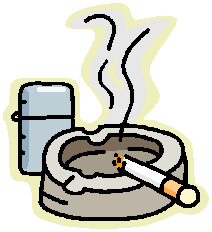To
Ban or Not to Ban?
A
WebQuest on the issue of Smoking in Restaurants

Introduction Task
Process Resources Evaluation
Conclusion

Introduction:
Congratulations! In one of the
closest races in recent memory, you have just
been elected to the County Council. You're happy about your victory but
need to get down to the business of making decisions, some of which may jeopardize
your chances of being reelected. The first of these divisive issues is
smoking. Many of your constituents are pushing for a complete ban on
smoking in restaurants. Not surprisingly, others are vehemently opposed to
it. On the one hand, you've heard that secondhand smoke is dangerous
to your health, but on the other hand, you worry about whether it's the
governments position to intervene in issues such as these.

Introduction Task
Process Resources Evaluation
Conclusion

Task:
To learn about the
issue, you decide to
read relevant newspaper articles and the mail you have received from your
constituents. You begin doing this but notice that there is such an abundance of
material that it would be almost impossible to read everything, so you and your
colleagues decide to divide up the work. In doing so, you will look at the problem
from a particular perspective and then share your knowledge with your fellow
Councilmen and women who will do the same. Once you have done this, the Council
will debate and vote on this question: Should the local government ban cigarette smoking in
restaurants in order to limit the effects of secondhand smoke? You will write a short “press release” stating how you voted and
explaining why you voted the way that you did.

Introduction Task
Process Resources Evaluation
Conclusion

Background for Everyone:
Before you divvy up the work, you will all read this
background material: National
Cancer Institute: Environmental
Tobacco Smoke. Read only the introductory section and the paragraph called
“Health Effects of ETS Exposure.”
OR
visit the Canadian Health Network site and read “How
Dangerous is Secondhand Smoke?
Process:
-
Your
teacher will assign you to a base group. Your group will be given one of the
following roles: Restaurant
Owners and Tobacco Companies, Non-smokers, Newspaper Journalists and other Media, and Public Health
Officials.
-
Work
alone or in pairs to visit at least two of the sites listed in the
"Resources" section for your role.
As you visit the sites, fill in any relevant information on the attached Decision
Making Guide. Follow the directions on that guide for completing the
chart, forming jigsaw groups, debating the issue with your jigsaw group, and
arriving at an individual opinion.
-
Use
the arguments and supporting facts you have circled to write an outline of
your views. Then write a thesis. It could start with
“The local government should ban cigarette smoking in restaurants
in order to limit the effects of secondhand smoke because…” or
“The local government should NOT ban cigarette smoking in
restaurants in order to limit the effects of secondhand smoke because…”
or you could choose your own wording.
-
Use
your outline to assist you in writing a press release. The press release
should be a one-page paper which states your opinion on the issue and
includes three arguments and facts to support that opinion. In it, you
should include a direct quote from yourself (a press release would normally
be written by one of the Councilperson’s staff members). Also include a
catchy title. For assistance with this process, visit the Learn2
Write a Press Release Site and read Steps 3 and 4.

Introduction Task
Process Resources Evaluation
Conclusion

Resources:
 |
Restaurant Owners and Tobacco Companies: |
 |
Non-Smokers
and Related Organizations:
|
 |
Newspaper
Journalists and other Media: |
 |
Public
Health Officials: |
 |
Editorial
in the American Council on Science and Health: Warning:
Overstating the Case Against Secondhand Smoke is Unnecessary—and Harmful
to Public Health Policy. |
 |
Statement
of Alfred Munzer, MD,Past President, American Lung Association, to the Senate
Environment and Public Works Committee Environmental
Tobacco Smoke. |
 |
Physicians
for a Smoke-Free Canada: Health
Effects of Secondhand Smoke. This article provides an overview of diseases
and deaths caused by second-hand smoke. |
 |
Other
Studies Support EPA on Secondhand Smoke, an article that appeared in The
Washington Post. |
 |
Article in the Health/Fitness Section of the Daily Camera: Secondhand
Smoke’s Danger Strikes Quickly. |
 |
Smoking
and Indoor Air Quality on the Health Canada site examines the effects of
secondhand smoke on health. |
 |
Kickbutt.org, an anti-smoking advocacy group, has a Learning
Center devoted to facts about tobacco. Read their article Secondhand
Smoke. |
 |
Kickbutt.org, an anti-smoking advocacy group, has a Learning
Center devoted to facts about tobacco. Read their article Secondhand
Smoke in Restaurants. |
 |
In Passive
Smoking: Nowhere to Hide, Health Canada examines the consequences smoking
has on others. |
 |
Physicians for a Smoke-Free Canada:
Ventilation
of Second-Hand Smoke is a page devoted to Questions and Answers on Ventilation
of Second-Hand Smoke.
|
Introduction Task
Process Resources Evaluation
Conclusion

Evaluation:
Your teacher will evaluate you using
the attached Rubric for Press Release.

Introduction Task
Process Resources Evaluation
Conclusion

Conclusion:
 |
Which interest groups support the
ban? Which oppose it? Why? In your opinion, which group has the most at stake?
|
 |
In a real-world scenario, how
would each group seek to influence the lawmaking process? Which group do you
think would be most influential? Which group do you think would be the least
influential? Why? What does this tell us about how public policy is made?
|
 |
How would the executive and legislative branches be involved in
the process? Can they be influenced? If so, how? |
 |
What responsibility do you as a citizen have to get involved in
the decision-making process? What opportunities are there for citizen
involvement in the lawmaking process? If you as an individual citizen wanted to
influence the local legislature about this matter, how would you go about doing
so? What other types of organizations or groups will be competing with you to
influence the process? How can you share your knowledge with others to convince
them to become involved? |
 |
How does this issue represent the balance the government seeks to
maintain between protecting rights and the common good? What does it tell us
about the relationship between government authority and individual liberty?
Regardless of how you feel about secondhand smoke, do you think it is the
government’s job to limit it by placing restrictions on where people can
smoke? |
 |
In general, should the government have the authority to limit some
people’s rights in order to protect the rights of others? What are some examples that support your opinion? |

Introduction Task
Process Resources Evaluation
Conclusion

Works
Cited
1. How Dangerous is Secondhand Smoke. (2001, July). Canadian Health Network.
Retrieved March 18, 2002 from World Wide Web: http://www.canadian-health-network.ca/faq-faq/tobacco-tabagisme/8e.html
2. The Toll of Tobacco in Maryland. (2002, March 18). Campaign for
Tobacco-Free Kids. Retrieved March 18, 2002 from World Wide Web:
http://tobaccofreekids.org/reports/settlements/TobaccoToll.php3?StateID=MD
All Clip Art courtesy of Microsoft Clip Art Gallery
Created
by Stacy
Farrar Dimmick,
Instructional
Technology Specialist, Montgomery County Public Schools, for

2002
Summer Institute
Back
to Top
|











